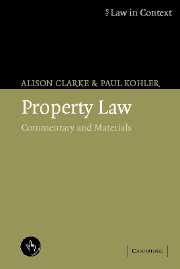Book contents
- Frontmatter
- Contents
- Preface
- Acknowledgments
- Table of cases
- Table of statutes
- Table of statutory instruments
- Table of treaties
- Table of EC legislation
- Part 1 The concept of property
- Part 2 The nature of proprietary interests
- Part 3 The acquisition and disposition of property interests
- Part 4 Proprietary relationships
- 16 Co-ownership
- 17 Leases and bailment
- 18 Security interests
- Bibliography
- Index
18 - Security interests
Published online by Cambridge University Press: 05 June 2012
- Frontmatter
- Contents
- Preface
- Acknowledgments
- Table of cases
- Table of statutes
- Table of statutory instruments
- Table of treaties
- Table of EC legislation
- Part 1 The concept of property
- Part 2 The nature of proprietary interests
- Part 3 The acquisition and disposition of property interests
- Part 4 Proprietary relationships
- 16 Co-ownership
- 17 Leases and bailment
- 18 Security interests
- Bibliography
- Index
Summary
The nature and function of security
Nature of security
A security interest is a proprietary interest in an asset owned by someone else, which is held only as security for the payment of a debt or performance of an obligation, in the sense that, as soon as the debt is repaid or the obligation is performed, the security interest ends.
Terminology problems
As we see below, there are four main types of security interest in English law: the mortgage, the charge, the pledge or pawn, and the lien. These are four quite distinct categories and they have different characteristics. The terminology, however, is not always strictly applied. In particular, the terms ‘mortgage’ and ‘charge’ are sometimes used interchangeably, and both are sometimes used as generic terms referring to any type of security interest. To compound the confusion, the only type of legal security interest that can now be created over an interest in land – the ‘charge by way of legal mortgage’ – is a statutorily created hybrid of the first and second categories, borrowing characteristics from both.
Another terminological oddity is that the lay terms used to describe secured transactions give a wholly inaccurate description of the technical nature of the transaction. In lay terms, aspiring property owners ‘get’ a mortgage (a valuable commodity) from a bank or building society (which is in the business of ‘offering’ mortgages to borrowers), and the bank or building society may then allow the owners to ‘keep’ the mortgage when they move house.
- Type
- Chapter
- Information
- Property LawCommentary and Materials, pp. 657 - 697Publisher: Cambridge University PressPrint publication year: 2005



